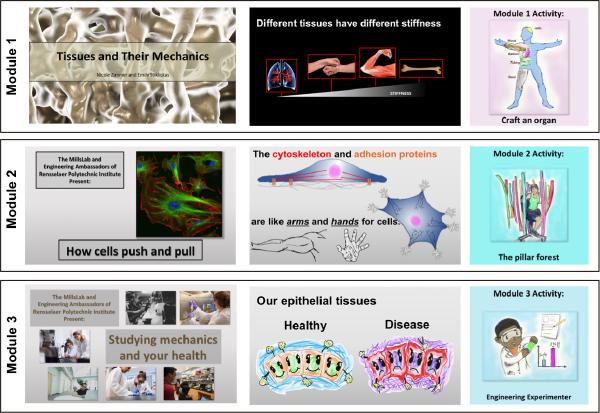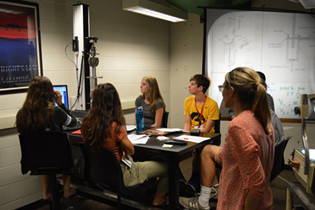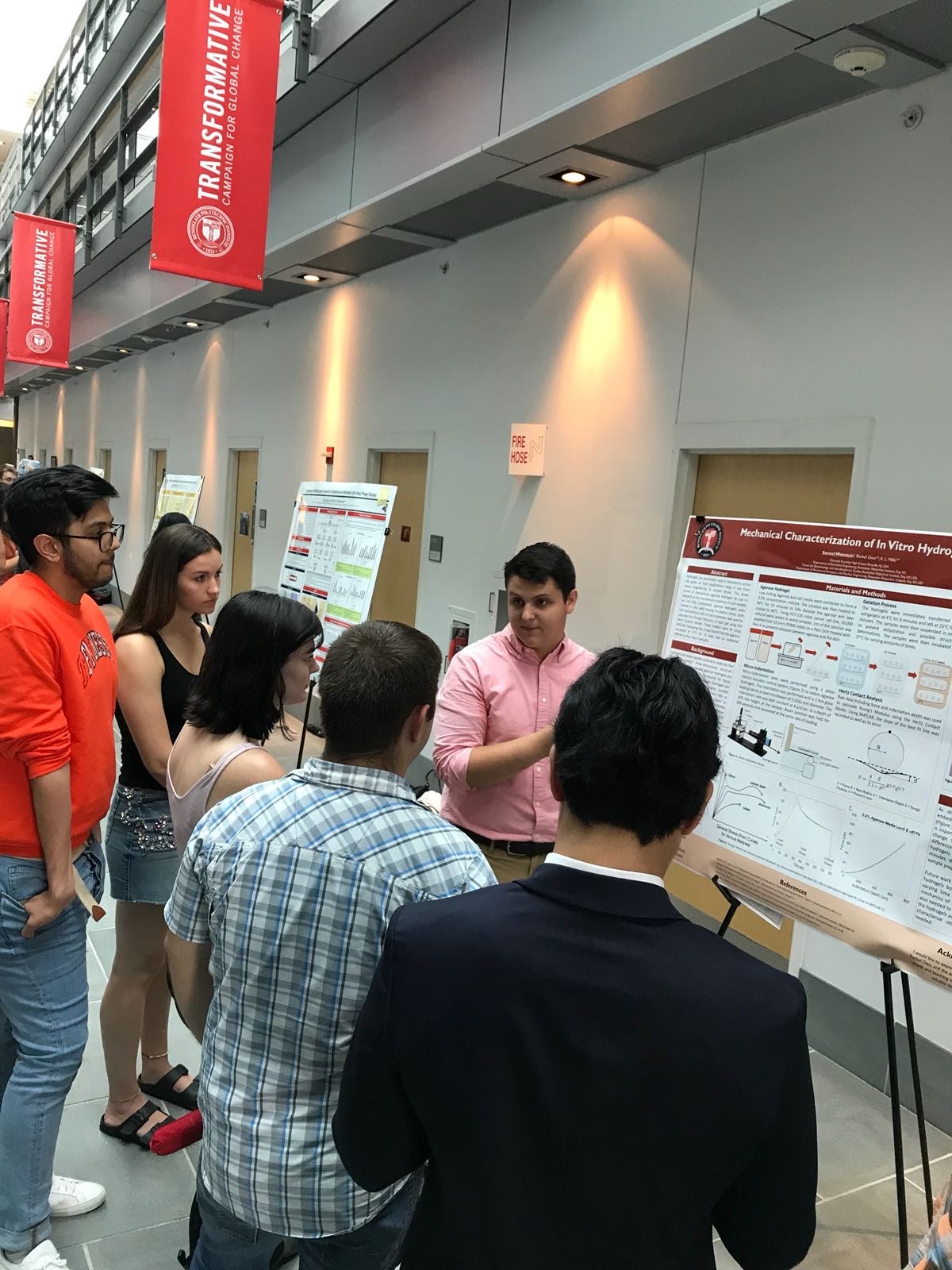Outreach and Teaching
Cell and tissue biomechanics outreach modules with the Engineering Ambassadors
Engineering is a diverse field with many applications and career paths. In this outreach program we engage students on the less traditional engineering topic of cell and tissue biomechanics. Cell and tissue biomechanics is the study of the mechanical properties of cells and tissues and how those properties relate to cell and tissue function. Discoveries in this important field have led scientists and physicians to understand the link between a tissue or organ’s mechanical properties (e.g., stiffness) and its health.
This program consists of three modules, taught sequentially, each with a presentation that is designed to engage the students and a hands-on activity to reinforce the material in a fun way. The first module (Tissues and Their Mechanics) provides the students with a strong foundation on a basic descriptor of mechanical properties—stiffness—and how it’s related to tissue function. The second module (How Cells Push and Pull) introduces the main components of tissues, cells and extracellular matrix, and focuses on how a cell interacts with the extracellular matrix. The third module (Studying Mechanics and Your Health) builds on the student’s understanding of the first two modules and the organization of cells in healthy and diseased tissues is discussed with respect to the known changes in the mechanical properties of the diseased tissue. Students will be able to see how a stiffer extracellular matrix, which develops in diseases such as cancer, will affect the behavior of cells.
We work with the Engineering Ambassadors, which is a group of motivated undergraduate students at RPI who are rigorously trained in student engagement and presentation skills to ensure the student audiences will have the best experience. The Engineering Ambassadors have an established relationship with schools across the Capital Region where they give similar presentations on a wide variety of STEM topics.
We aim to engage students in the foundational concepts that are currently used in innovative labs across the country to understand disease progression and discover health solutions and treatments and thereby inspire students, especially those who might not otherwise consider a career in STEM. By introducing cutting edge and exciting concepts at the junction between cell biology and mechanics, we aim to inspire and to broaden the high school student’s ideas of what a career in engineering can look like.
To assess the success of our program, pre- and post - program surveys will be given to the students to ensure that the modules have increased the students’ awareness of the field and their interest in pursuing a STEM career. The information from these surveys will be used to continually adapt the presentations to ensure the students are able to meet the goals outlined above for each presentation.

Hands on experience with engineering curricula for high school students in the Engineering Exploration Program, Summer@Rensselaer

This week-long residential or commuter program for rising high school juniors and seniors provides a hands-on introduction to 8 engineering programs at RPI: Electrical Engineering, Materials Science and Engineering, Chemical and Biological Engineering, Mechanical Engineering, Manufacturing, Aerospace Engineering, Civil Engineering, and Biomedical Engineering. The students additionally form teams to work on a week-long engineering project consisting of designing, prototyping, and testing. The students present the results of their project at a gathering on the final day for all attendees and their family and friends.
Note: this program was cancelled for Summer 2020 due to COVID-19.
Bringing high schooler students into the lab with the Rensselaer Research Experience, Summer@Rensselaer

The Mills Lab has hosted two high school students as part of the Rensselaer Research Experience Program (Summer@Rensselaer). The goal of the program is to provide high school students the unique opportunity to conduct research and develop new competence in scientific work. The program focuses on instilling the following skills, which are essential for developing strong research attitudes and practices: (1) develop a research plan, (2) keep a laboratory notebook, (3) analyze data, (4) present data, and (5) learn lab techniques and background information for future independent work. During the summer of 2017 our lab hosted Trijal Kodui and during the summer of 2018 we hosted Samuel Weinstein. Both students were recognized in the poster competition for their excellent work!
Strength of Materials (RPI, ENGR 2530)
How do materials behave under different loading conditions? How much stress do they experience? And, how much will a given structure deflect under a given simple loading condition (axial, torsion, or bending)? The concepts of stress and strain are defined as an introduction to learning how to answer those. By the end of the course, students should have a general understanding of how to design a structure for strength and/or deflection and determine where maximum stresses occur in structures under mixed loading conditions. Please see current course catalog for more information.
As engineering students are known to be largely visual and active learners (Felder and Silverman, 1988), I’ve been experimenting with visual and tactile aids for reinforcing the concepts in this course. Specifically, foam beams in the form of rectangular or circular cross-sections, onto which a regular grid is drawn, may be used by the instructor to demonstrate the resulting deformations in the member due to applied loads (Figure, based off of the design by Jacques Maurel). The students may also handle the beams when passed around class or during office hours and use them to visually reinforce their understanding.
Currently, four computer science (one dual mechanical engineering and computer science) undergraduate research students are building an application that will extend the usage of the physical foam beams into an augmented reality tool for visualizing stress distributions in the beams. Users will be able to bend a foam beam in front of a laptop camera and see stresses represented as vectors and cross-section heat maps in real time. The application is being written in the Java programming language, targeting PC users. We are using the Aruco marker detection library, a subset of the OpenCV computer vision library, along with some other OpenCV utilities. Java Swing is being used for representing stresses as heat maps
Mechanical Systems Lab (RPI, MANE 4040)
Hands-on experience in conducting mechanical systems testing based on knowledge gained in Elements of Mechanical Design (MANE 4030). Topics covered include dimensional measurement and tolerancing, stress and strain measurement in tension and bending, contact mechanics, sliding friction and wear, fasteners, shafts and gears, and mechanical component design and analysis. For each experiment predictive calculations are compared to experimental results and discrepancies, including sources of experimental error, are discussed. Students work in groups of 4 to 5, rotating leadership positions to perform the experiments and write lab reports.
Experimental Mechanics (RPI, MANE 696X)
In this course we will study the design and analysis of experiments in solid mechanics including some aspects of biological soft tissues. Methods for experimental stress analysis and the mechanical testing of materials will be discussed. Measurement techniques including instrumentation and data acquisition for key mechanical parameters such as displacements and forces (point and full-field measurements). Mechanical behaviors include creep and relaxation, high strain rate, fracture, and fatigue.
Mechanics of Cancer and Soft Materials (Ulm University, Advanced Materials Program)
The tissues of our body possess very specific mechanical properties that are intimately related to their function. For example, the stiff bones of our skeleton must carry our weight, whereas breast tissue must be able to accurately respond to much lower forces, such as the suckling action of a baby. The mechanics of tissues are often altered in disease. In this course, we will introduce first the healthy organization of tissues and how cells transmit and transduce forces in a healthy environment. Then talk about specifically how tissue mechanics are altered in solid tumors in soft tissues (epithelia).
© 2015 Kristen Mills. Statements.